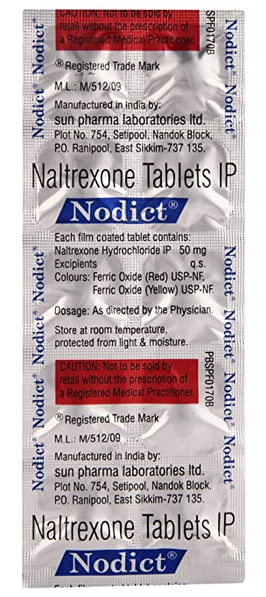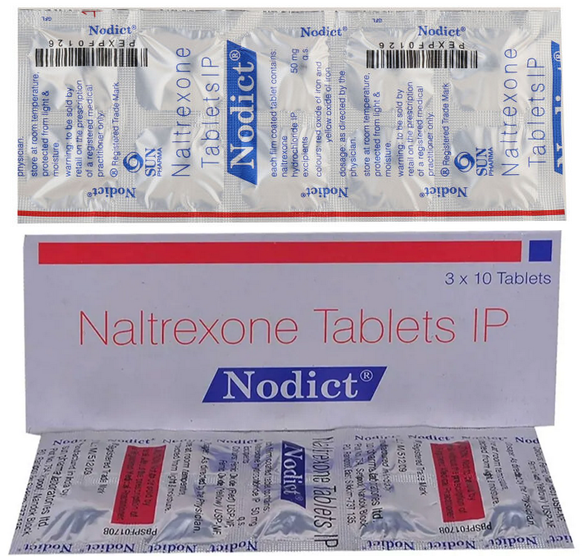Buy Cheap Nodict® 50 mg Online
Nodict® 50 mg is used for alcohol dependence (with the consent of the patient and in combination with psychotherapeutic and social methods), prevention of pharmacological effects of exogenous opioids to maintain an opioid-free state in patients with opioid dependence after pre-detoxification (as part of a program of psychological and vocational rehabilitation).
- Brand: Nodict® 50 mg
- Composition: Naltrexone
- Power: 50mg
- Treatment: Alcoholism, Alcohol dependence and abstinence
- Manufacturer: Sun Pharmaceutical Industries Ltd.
- Country of Origin: India
Using Nodict® 50 mg:
- Treatment of alcohol dependence in patients who are able to refrain from taking alcohol before starting treatment (patients should not actively consume alcohol at the beginning of treatment with Nodict® 50 mg);
- Prevention of relapse of opioid addiction after opioid detoxification (patients should not take opioids at the beginning of treatment with Nodict® 50 mg).
- Treatment with Nodict® 50 mg should be part of an appropriate program to eliminate alcohol dependence, including psychosocial support.
Pharmacology:
Pharmacological action – blocking opiate receptors. Competitively blocks the binding of agonists or displaces them from opiate receptors. Reduces or relieves symptoms caused by intravenous administration of opiates. It has the greatest affinity for mu and kappa receptors.
Nodict® 50 mg Treatment of alcoholism
- The minimum course is from 3 months, the standard course is 6 months.
- Daily intake is 50 mg, the minimum course is 3 months.
- Treatment is not started until a naloxone test is performed to exclude the presence of opioids in the body.
Nodict® 50 mg course of treatment

Treatment can be initiated after abstinence from taking drugs for 7-10 days (identified by urine tests). The patient should have no “withdrawal” syndrome and signs of withdrawal. Treatment is not started until the provocative test with naloxone becomes negative.
- The initial dose is 25 mg, the patient is monitored for 1 hour, in the absence of abstinence, the remaining part of the daily dose is administered.
- The average dose is 50 mg / day, sufficient to block parenterally administered opiates (this dose blocks 25 mg of heroin administered intravenously).
Long-term appointment does not cause tolerance and dependence. Combination with opioids in large doses leads to an increase in the release of histamine with a characteristic clinical picture (facial hyperemia, itching, rash).
In patients with opioid addiction, it causes an abstinence attack. In alcoholism, it binds to opioid receptors and blocks the effects of endorphins. Reduces the need for alcohol and prevents relapses for 6 months after a 12-week course of therapy (the success of treatment depends on the patient’s consent).
Alternative treatment regimens:
- 50 mg every weekday and 100 mg on Saturday;
- 100 mg every other day;
- 150 mg after 2 days;
- 100 mg on Monday, 100 mg on Wednesday and 150 mg on Friday.
There are also other schemes:
50 mg for the first 5 days of the week and 100 mg for the sixth day; 100 mg every 2 days or 150 mg every 3 days; 100 mg on Monday, 100 mg on Tuesday and 150 mg on Friday. It should be borne in mind that the use of these treatment regimens increases the risk of hepatotoxicity.
Precautions Nodict® 50 mg:
Before using Nodict® 50 mg, it is necessary to exclude subclinical hepatic insufficiency, during treatment, the level of transaminases should be periodically monitored; it cannot be combined with drugs with hepatotoxic properties. To prevent the development of acute withdrawal syndrome, patients should stop taking opioids and drugs containing them at least 7-10 days in advance, it is mandatory to determine opioids in urine and conduct a provocative test with naloxone; if these requirements are not met, withdrawal syndrome may occur 5 minutes after administration and continue for 48 hours.
Against the background of naltrexone, in case of emergency analgesia, opiates in an increased dosage are prescribed with caution only with narcotic drugs (to overcome antagonism), since respiratory depression will be deeper and longer.
Patients should be warned that:
- when seeking medical help, they are required to inform medical professionals about the treatment of Nodict® 50 mg naltrexone;
- in case of abdominal pain, darkening of urine, yellowing of the sclera, it is necessary to stop taking it and consult a doctor;
- with the independent use of heroin and other drugs in small doses, there will be no effect from their use, and a further increase in the dose of narcotic drugs will lead to a fatal outcome (respiratory arrest).
Nodict® 50 mg Naltrexone
- Drugs for the treatment of alcohol dependence (Drugs for the correction of disorders in alcoholism, substance abuse and drug addiction);
- Opioid receptor antagonist (Detoxifying agents, including antidotes);
- Opioid receptor antagonist (Means for correction of disorders in alcoholism, substance abuse and drug addiction);
- Opioid receptor antagonist (Opioid non-narcotic analgesics).
Side effects of Nodict® 50 mg
From the digestive system:
Decreased appetite, diarrhea or constipation; rarely – dry mouth, flatulence, worsening of hemorrhoid symptoms, erosive and ulcerative lesions of the gastrointestinal tract, abdominal pain, increased activity of “liver” enzymes, increased or decreased appetite, weight gain.
From the nervous system:
Excitement, prostration, irritability, dizziness; rarely – depression, paranoia, fatigue, confusion, disorientation in time and space, hallucinations, “nightmarish” dreams, drowsiness, decreased visual acuity, pain and burning sensation in the eyes, photophobia, pain and a feeling of stuffiness in the ears, tinnitus.
From the respiratory system:
Bronchial obstruction, nasal congestion (hyperemia of the vessels of the nasal cavity), rhinorrhea, cough, difficulty breathing, shortness of breath, nosebleed, sneezing, dry throat, increased mucus secretion, sinusitis.
From the side of the CCC:
Rarely – phlebitis, edema, increased blood pressure, nonspecific ECG changes, tachycardia, a feeling of heat in the extremities, a feeling of a sudden rush of blood to the face.
From the skin:
Rash; rarely – increased secretion of sebaceous glands.
Other:
Facial hyperemia, generalized skin hyperemia, erythematous rashes, arthralgia, myalgia, chills, hemorrhoids, acne, alopecia, itching, delayed ejaculation, decreased potency; rarely – increased or impaired urination, increased or decreased libido, pathological yawning, fever, pain in the groin, enlarged lymph nodes, lymphocytosis the development of idiopathic thrombocytopenic purpura is described.
Interactions of Nodict® 50 mg
The interaction of Nodict® 50 mds with other drugs has not been studied.
- Nodict® 50 mg Naltrexone is an antagonist of opioid-containing drugs (for example, cough medications, colds, antidiarrheal medications and opioid analgesics).
- Since naltrexone is not a substrate of cytochrome system enzymes, inducers or inhibitors of these enzymes are unlikely to affect the clearance of Nodict® 50 mg. No studies have been conducted to assess the clinical significance of the effect of other drugs on the metabolism of Nodict® 50 mg, therefore caution should be exercised and possible risks and potential benefits should be assessed when prescribing Nodict® 50 mg together with other drugs.
- The safety indicators of using Nodict® 50 mg together with antidepressants and without them are the same.
- Some drugs containing opioids (including antitussive, anti-inflammatory drugs, narcotic analgesics) may not cause the desired effect in those taking Nodict® 50 mg. In these cases, alternative drugs that do not contain opioids should be used.
- Hepatotoxic drugs increase (mutually) the risk of liver damage.
- Lethargy or increased drowsiness may occur when combined with thioridazine.
- Accelerates the appearance of withdrawal symptoms on the background of drug addiction (symptoms may appear as early as 5 minutes after administration of the drug, last for 48 hours, are characterized by persistence and difficulty in eliminating them).
Cases of incompatibility with drugs of other pharmacological groups are not described.



